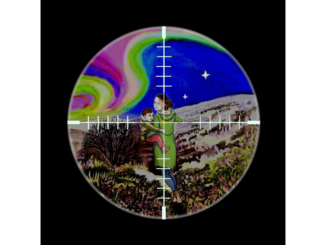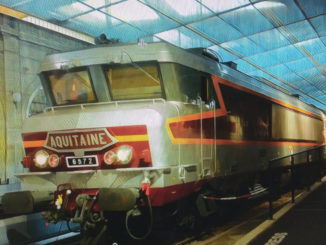Cannes

© Always Worth Saying 2023, Going Postal
Having pestered the French Air Force at Istres last time, this time we’re striking out from there along the Cote d’Azur in diréction Cannes.
Above we see the fishing port side of the town captured during my grandparent’s 1958 road trip. Still recognisable as a working harbour, close to the camera sit fishing boats containing bundles of nets to forward. In the distance, leisure yachts rest with sentinal masts swaying before the waterfront of Quai Saint Pierre. The scene is still recognisable today. Sort of. The same row of buildings is visible but with a different pedigree of sailing vessels lashed to the harbourside.
Gone are the fishing boats (known as gréments because of their busy tangle of ropework of rigging and pulleys) and modest sailing yachts. The entire port is now a marina with a Morrison’s car park of nouveau riche indulgences. The buildings remain refreshingly the same – if you can make them out amongst the expensive metal. However, useage has changed. One suspects they may have, at ground level at least, been eateries seven decades ago but as Irish pubs? Surely not.

© Google Street View 2023, Google
To the east of the old port/fishing harbour lies the beaches and hotels. Less likely to have changed since the 1950s as the big development came in the previous century with the invention of tourism.
Our photo gives us little to go on, just a row of palms beside the road. But they are still there and line the Boulevard de la Croisette. Captioned ‘Cannes Cacti’ we shall imagine ourselves admiring the pots outside the Hotel Carlton Intercontinental. Take a look around in the modern day via the following link.

© Always Worth Saying 2023, Going Postal
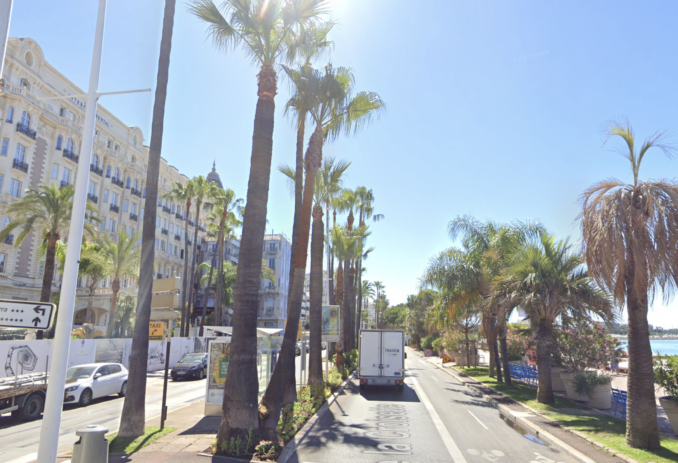
© Google Street View 2023, Google
As we wind the clock back we will people-watch. Of course, even in the 1950s Cannes was a watering hole to the rich and famous not least during the annual May film festival. By 1958 it was in its 11th year. Stars photographed at the Festival International Du Film included Sophia Loren, Gina Lollobridgia (who died only last month), Yves Deniaud, the actor-comedian Bourvil and Jane Mansfield with her husband Mickey Hargitay.
Films competing for the coveted Palm d’Or included French comedian and national treasure Jaques Tati’s Mon Oncle, a sidesplitting romp through postwar France’s infatuation with modern architecture, mechanical efficiency and consumerism. House points deducted from any Puffin thinking ‘sounds about as funny as Nish Kumar.’
Also present at the festivities, Rossana Podesta and husband Marco Vicario presumably promoting The Sword and the Cross. Or Raw Wind in Eden. Or The Amorous Corporal. Yes, the stars used to bash out three films a year in those days (although probably not all before May).
In further proof that God exists and only one degree of separation divides all, I’m sure that Puffin’s favourite French film star Mlle Véro at one time starred alongside La Posdesta. Purely in the interest of thoroughness, I’ve rewatched Sodom and Gomorrah, Les Seducteurs, Seven Dangerous Girls, Sex Diary, The Naked Hours and Homo Eroticus, and although Rosanna is there experiencing all the ups and downs of an ageing starlet’s career in entertainment, there is no sign of Mlle Véro. I shall watch them all again, just to be sure.
Speaking of l’amor and slightly older Continental ladies, after a disappointment of the heart, a friend thought he might join the Foreign Legion to forget. After dispatching himself to Aubagne or some such place, he discovered that the selection process included being able to swim 50 meters in about an hour, run a mile (well, 1500m) in twenty minutes and carry a bag of shopping for five miles in your own time. The difficult bit was doing it all in French. The dialogue the broken-heart had learned with his amour was somewhat limited and inappropriate to a barrack room – even a French one. To be blunt, he found the Legion a bit naff, made an excuse and left long before signing his life away while being presented with a ceremonial axe.
On the western side of the old harbour lies the Boulevard du Midi Louise Moreau and the Plage du Midi beach. These are cut off from the township by the main railway line. On the landward side sit villas rather than hotels. The line runs through the middle of Cannes but underneath a road from the Rue Georges Clemenceau until the Roundabout du General Maubert. All of this is news to me via Google Maps. In my day, the 1980s, as you may recall from the last episode, I didn’t stir from my L’Esterel bunk until Nice, 18 miles further along the coast.
Nice
Arrival by rail at Nice, on L’Esterel or otherwise, is at the rather pompous Gare Nice-Ville. The station was completed in 1867 for the Chemins de fer de Paris à Lyon et à la Méditerranée railway company (better known as the PLM) and was designed by Louis-Jules Bouchot in a Louis XIIIth style. Bouchot was well known for his railway stations and also designed Milan Central, Gare de Valence, Gare d’Avignon-Centre and Gare de Toulon.
The Mike Yarwood of the Louis XIIIth stye, his stations were all a bit too similar to each other but impressive all the same. Note – his 1864 Milan Central isn’t the current Milano Centrale which dates from 1931. As for the Louis XIIIth look itself, it is easier to recognise than to describe:
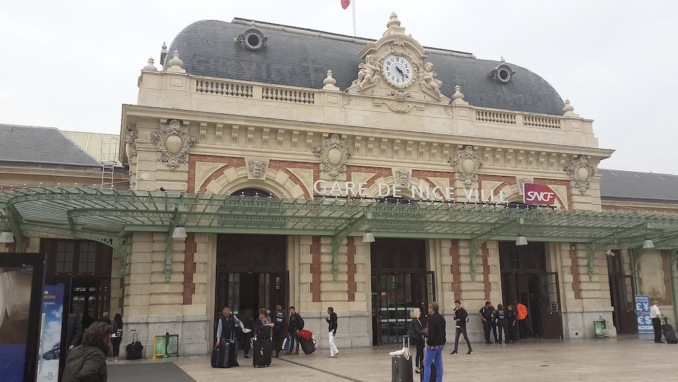
Gare de Nice-Ville,
Yair Haklai – Licence CC BY-SA 4.0
From the three-arched portico, it is a pleasant enough three-quarter of a mile stroll through narrow streets to the Promenade des Anglais and the Meditterainain sea beyond. Next stop Algeria, with a chance to wave at Corsica and Sardinia to port while passing.
Two observations about the seafront. The beach is stoney, of ‘galets’ rather than sand, and is too close to the noisy Aeroport Nice Cote d’Azur which is built on reclaimed land literally at the western end of the beach.

© Always Worth Saying 2023, Going Postal
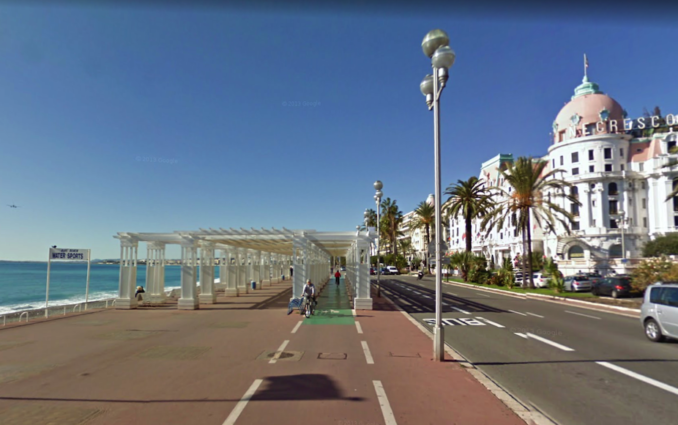
© Always Worth Saying 2023, Going Postal
In the modern day, the promenade has been improved with a cycle path and a better surface but a trellis gets in the way. A noisy aeroplane can be seen on the far left, half way up the image. Looking at my own photo, to the right we can spot two noticeable domed roofs on street corners. The nearer is Le Necresco. According to the guff,
What other palace best symbolises the legend of the French Riviera? More than 100 years after its creation, as the perfect image of the legendary Riviera, Le Negresco reveals our desire for enjoyment, relaxation and comfort.
The Negresco is named after Alexandru Negrescu (also known as Henri), a Romanian emigre who, via the Cash Capsa in Bucharest, Paris and the municipal casino in Nice, built the cafe society Negresco Hotel to the design of Edouard-jean Neman. The dome is famous and is pink.
The second dome is 37 Promenade des Anglais and sits on the corner of Rue Crondstadt. If anything, superior to the Negresso it is more finely decorated and more pleasingly proportioned. A plaque is attached at ground floor level on the Rue Crondstadt side. Partly concealed by scaffolding on Street View, it is only possible to make out, “Who by his commitment … under occupation … saved thousands of … and vow to be delivered to the … by the authorities.”
The surname on the dedication can’t be made out but the first name appears to be Angelo. Further investigation shows the Angelo concerned to be Angelo Donati, a Jewish Italian banker, philanthropist and San Remo diplomat. At the capitulation of France, Donati fled south from Paris to Marseille and landed in Nice where he became a director of the Franco-Italian Bank. During the next part of the war, he used his influence, contacts, tact and guile to protect Jews from the Italian occupying force and their more enthusiastically anti-Semitic German allies. When Italy left the war his influence waned and he himself had to flee, eventually reaching safety in Switzerland.
After the war, he resumed the life of a diplomat and died peacefully in Paris in 1960. It was in February 2016 that the plaque was unveiled. Months later another tragedy was to strike Nice. One which, by coincidence, is commentated further along the Rue de Crondstadt.
Our next photo is further around the seafront looking back towards the Negresco whose dome can be seen in the middle distance and slightly to the right. Our landmark is a sign for the Bambou beach restaurant bar which has survived and means we can stand in the exact same spot. The effect of Google’s wide-angle lens is noticeable when compared to my old zoom.
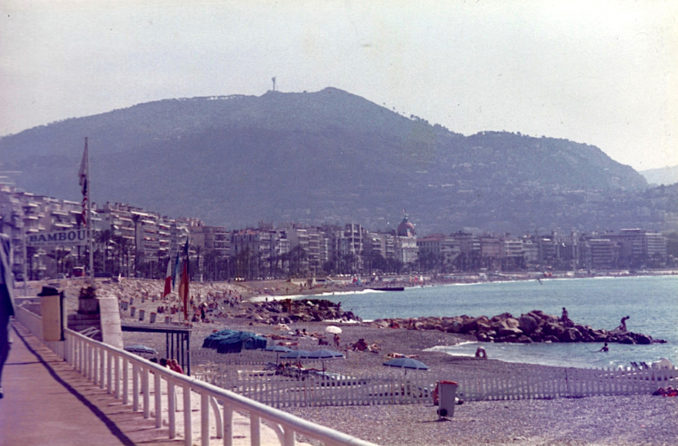
© Always Worth Saying 2023, Going Postal
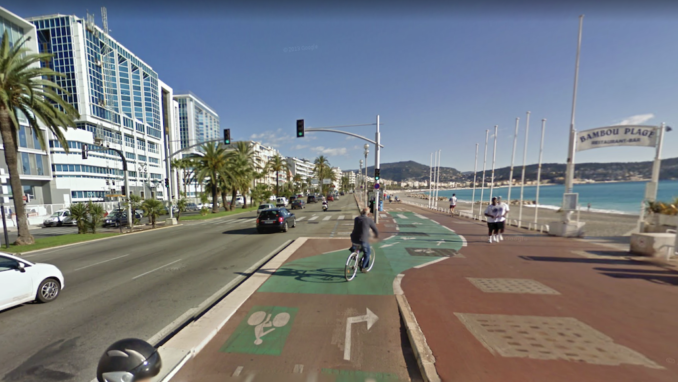
© Google 2023, Going Postal
Situated opposite Rue Lenval, it was along here that catastrophe struck on 14th July 2016. Eighty-six people were murdered and 434 injured when a Muslim terrorist drove a truck through Bastille Day crowds enjoying a firework display. The atrocity began at 1030 pm, at the interchange between the Avenue de Fabron and the promenade, less than 300 yards west of the Bambou. The truck was driven through crowds for one and a quarter miles before the terrorist was shot and killed by French police outside the Palais de la Mediterranee hotel which lies just past the Negresco.
A signpost to the monument to those murdered in the terrorist outrage stands on the Rue du Comstradt, beside the plaque to Angelo Donati. It directs to the Musée Masséna. In the gardens behind the museum, and backing onto the Promenade des Anglais, sits a memorial with the names of those murdered beneath an inscription that reads, ‘In memory of our angels.’

Mémorial en hommage aux victimes de l’attentat du 14 juillet 2016 à Nice.,
Benoit Prieur – Public domain
© Always Worth Saying 2023


